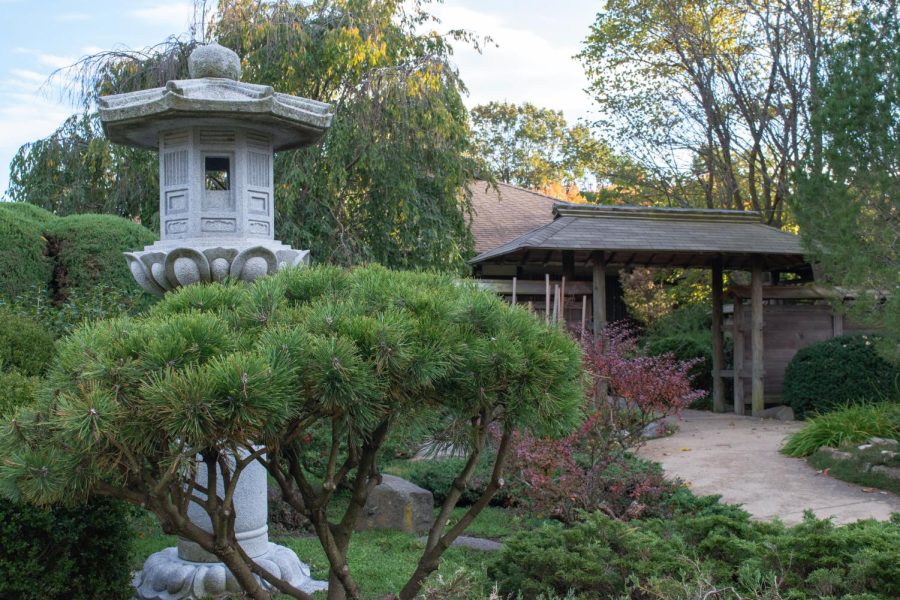Japan House boatbuilding course floats Japanese learning styles
ARTJ 391: Independent Study in Japanese Aesthetics provides students with a hands-on experience in creating boats utilizing Japanese techniques. The class is held at the Japan House.
Apr 14, 2022
This semester, the Japan House held a course in which students were able to learn how to build a boat using traditional Japanese techniques. The course, ARTJ 391: Independent Study in Japanese Aesthetics, included seven weeks of remote work and one week of hands-on learning with Japanese boatbuilding expert Douglas Brooks.
The course was organized by Japan House Education Associate Diana Liao. After securing the funding needed for the course and building a syllabus, Liao was able to bring her vision to fruition.
Liao says her motivation for the course was the return to in-person classes.
“Since it seems like most everyone has the opportunity to come back to campus, I thought we should really just kick it off with something really exciting and hands on,” Liao said.
The first seven weeks of the course were held remotely and used Brook’s book, “Japanese Wooden Boatbuilding,” as readings. For credit, students were asked to respond to what they had read in journal entries and reflections.
Get The Daily Illini in your inbox!
For Madison Yang, junior in Engineering, the readings reflected her own cultural background. As an Asian-American, the comparison between western and Japanese techniques in the readings was reminiscent of the cultural influences in her own life.
“A lot of the readings compared Japanese traditions and customs to Western equivalents, specifically related to craftsmanship,” Yang said. “It was interesting for me to study this comparison as someone who is culturally influenced by both, being Asian-American.”
The final week of the class was held in person, with Brooks presiding over the students’ learning. The class was taught according to Japanese apprenticeship customs which, as Liao describes, did not include a guidebook.
“In Japanese apprenticeships, there’s no lecture, there’s no textbook, and everything is done through oral tradition and their hands-on experience,” Liao said. “So you’ll never have a textbook saying like, ‘Oh, here’s how to build a boat, here’s the plans to do these problems.’”
Liao said Brook’s approach to teaching the course was relying on students’ commitment to the class.
“He said, ‘No, we’re not going to do any quizzes. You just do it. And your craftsmanship and your dedication to actually making the technique work is going to be what makes this boat float or sink,’” Liao said.
For a week, students worked on the boat for three hours a day. Yang said the aspect of working hands-on made the course even more appealing.
“It was strenuous for sure, but I really enjoyed being able to work with my hands on something and then actually being able to ride in the boat,” Yang said.
Yang further detailed how wood planing became one of her favorite parts of making the boat.
“Specifically, I really enjoyed planing, which is a process where you shave off thin sheets of wood,” Yang said. “The planing tool is a pretty simple block with a blade, but I felt like without a lot of force it was able to have a strong impact. I had a lot of fun sitting there for an hour or so taking off thin shavings of wood to try to make the oar round.”
In accordance with apprenticeship customs, the students were asked to refrain from bringing distractions to their workspace, including music or headphones.
“We were asked to stay silent and weren’t allowed to listen to music through headphones or anything while we worked,” Yang said. “I thought it would be a nice break and allow me to think my own thoughts while I worked, but everything that I did took my full attention at all times, so I wasn’t really able to think about everything else.”
For Mikayla Blanke, junior at University of Illinois Laboratory High School, the class served as a way to expand her knowledge of Japanese culture after taking three years of Japanese language courses. She describes how the group effort eventually produced a traditional Japanese riverboat, which students then launched in a traditional ceremony.
“We worked together to saw, chisel, measure, etc., and by the end of the week, we had a full-sized boat ready to launch,” Blanke said. “The launching ceremony consisted of Shinto traditions where we honored the many spirits involved with the boat and the pond.”
For Blanke, the class served as a way to expand not only her knowledge of the culture but of other students with an interest in Japanese traditions and customs.
“It was such a unique and fun experience to learn how to use all the tools, while still staying true to Japanese culture,” Blanke said. “It was also really fun to meet the other students, who were from different backgrounds and majors.”
With the course behind them, Liao has been reading the reflections of the students involved in the class. Liao shares that many commented on the difference in the teaching styles between Japanese and western cultures.
“The reflections that have been coming back after the class, a lot of students are just writing about how insightful it was and how meditative it was,” Liao said. “It was the idea that we’re so used to this American style way of thinking and teaching and learning that we don’t think that there are so many other opportunities and other cultural ways of learning.”






